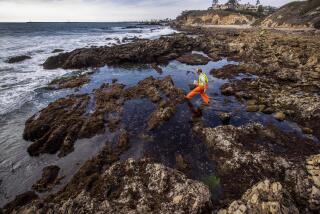Tests before Deepwater Horizon explosion showed faulty cement, panel says
- Share via
Reporting from Washington — Weeks before the Deepwater Horizon exploded and sank, oil company BP and subcontractor Halliburton learned that tests had shown the cement mixture designed to seal the well was unstable, but they continued to use it anyway, President Obama’s special commission investigating the environmental disaster reported Thursday.
The cement mixture is used to secure the metal casing around the string of pipes and the drill bit as they penetrate the reservoirs of oil and gas lying deep beneath the ocean floor. Cement also is supposed to keep oil and gas from pushing back up the well, causing a blowout.
After running independent tests on the particular cement mix Halliburton used and reviewing the company’s documents, the commission’s chief counsel sent a letter to commission members saying that BP and Halliburton had information about problems with the cement mix they were using in the well but did nothing about it.
“Halliburton and BP both had results in March showing that a very similar foam slurry design to the one actually pumped at the Macondo well would be unstable, but neither acted upon that data,” the letter said.
The explosion that sank the oil rig, killed 11 members of its crew and sent millions of gallons of oil spewing into the Gulf of Mexico has become the subject of a Justice Department investigation and numerous lawsuits and other legal actions seeking to hold BP, Haliburton and others liable.
The finding by investigators for the presidential commission is expected to provide fresh ammunition for the companies’ critics and could increase the likelihood of action by the Justice Department.
The chief counsel of the commission, Fred Bartlit, wrote that his office looked into the kind of cement used because of the widely held assumption that emerged right after the explosion “that the cement used to secure the production casing and isolate the hydrocarbon zone at the bottom of the Macondo well must have failed in some manner. That cement should have prevented hydrocarbons from entering the well.”
In the lower section of the well, which reached 13,000 feet below the ocean floor, BP chose to use a type of cement recommended and made Halliburton that is infused with nitrogen. The gas makes the cement slurry lighter and, theoretically, able to form a stronger bond between the production casing and the earth around it.
But getting the recipe right can be tricky, and oil-field service companies like Halliburton regularly test their cement mixes for stability.
As part of its inquiry, the commission counsel’s office got the formula from Halliburton for the nitrogen foam cement used in Deepwater well and had another oil company with expertise in cementing, Chevron Corp, test it.
“Chevron’s report states, among other things, that its lab personnel were unable to generate stable foam cement in the laboratory using the materials provided by Halliburton and available design information regarding the slurry used at the Macondo well,” the letter says. “Although laboratory foam stability tests cannot replicate field conditions perfectly, these data strongly suggest that the foam cement used at Macondo was unstable. This may have contributed to the blowout.”
More to Read
Sign up for Essential California
The most important California stories and recommendations in your inbox every morning.
You may occasionally receive promotional content from the Los Angeles Times.













